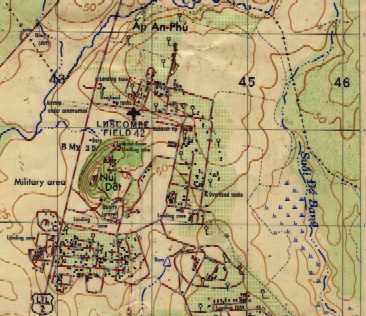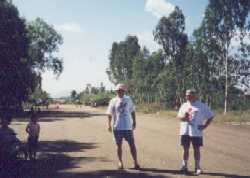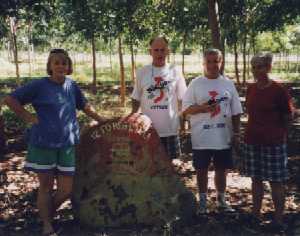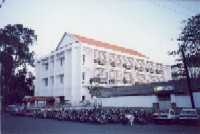|
| ||
|
To 161 Battery in Vietnam |
R & RTwo ex-members of 161 Battery, RNZA re-visit Vietnam |

|
|
| ||
|
Saigon. Mr Kiet is our guide and Mr Rice our driver. They say they know where to take us. Baria, Nui Dat, the Horseshoe, Luscombe Field and Vung Tau. We leave Saigon and its motor-scooters. Little ones with from 1 to 5 passengers. A whole family sitting on the bike. The strangest thing we have seen on a motorbike was a bloody big live pig. It was lying on its back on the pillion seat with its feet and everything else (it was a boar) stuck up in the air. We cross a branch of the Saigon River. It really is grotty. The pollution is terrible. We are on the main road out of Saigon. It is a wide road with many lanes but traffic goes in every direction in every lane. No road code here! Our guide tells us that this is Route 1. It was initially built by the Americans and built wide as an emergency landing strip. The one or two planes that have used it in an emergency had nasty accidents with the traffic on the road There is a lot of traffic. Very little military traffic. It is hard to recognise soldiers anyway because there are a lot of other coloured uniforms for Postmen and the like. A long line of trucks drives past with flags flying left, right and centre. Our guide told us it is an anti drug campaign. He said that drugs are a big problem in the universities and 47 people were arrested by the police for trafficking last week. We pass a Coca Cola factory. We turn right off Route 1 towards Baria. A T intersection. Straight on is Bien Hoa. On the left is Long Binh. Our guide tells us it was the biggest US air base and the airport for Bien Hoa. There were 72 watchtowers around the base. Then he told us about the Americans at My Lai and how Lt Kelly and others killed over 500 people. About 45 kms from Saigon city we pass through Long Tan. We pass a "Welcome to Baria/Vung Tau Province" sign. It used to be Phuoc Tuy. Baria is becoming well known for its seafood. There are some oil drilling rigs off the coast of Vung Tau. Quite a modern city by Vietnam standards - supermarket, wide main street. We turn left towards Nui Dat and Rod remembers playing rugby at a sports stadium in Baria. We pass a South Korean and Vietnamese joint venture shoe factory. Staff wear a uniform and very smart they look too.  We pass a milestone pointing towards Xuan Moc. We pass another indicating Hoa Long. We all know about the dance that they used to hold at Hoa Long on Saturday nights. We stop again and the guide points out The Horseshoe. The Horseshoe is now owned by the Government. It is a quarry. We hike up to the top. To the Southeast, in the distance, is a burn-off chimney for a natural gas field. I recall the road down to the Southwest. We used to fire the curfew guns at 5 or 6 o'clock or something. We stand on the top of the Horseshoe and look South towards the Long Hai's. The notorious Long Hai's mines and all. We recall deploying here to fire into the Long Hai's. We look north wondering if that little hill out there (5 kms away) is Nui Dat. I remember standing up here years ago and looking down at the police road block. Rod recalls that "When we came out here the first time an Australian battery was already in the prepared positions and the American 155's were also here. 161 had to deploy forward and prepare their own positions. This was an arsehole of a place to try and dig in - it is solid rock, scoria. I remember trying to dig my shell scrape the first day I was here and tearing the skin off my hands and thinking God am I going to last the whole 12 months digging holes in stuff like this. Funnily enough the next place we deployed to was soft sand and when you dug a hole it all fell in on top of you. So it was quite a contrast." I don't recall digging too many deep pits. I recall getting the half round pressed steel, digging down a couple of feet, then putting that over the top and then sandbag the lot. We now head North. There are many little houses on the side of the road and everyone seems to be ensconced in front of their televisions. It is just after noon. Our guide tells us we are heading to the Long Tan memorial. The road is just like a farm track, typical red laterite earth. All agricultural land. A lot of rubber plantations - all fairly newly planted. We walk through the rubber plantation and there is the memorial. Just a simple white cross - no plaque - and just a wire fence around it. Nothing to identify it. Evidently the original one was taken by the Vietnamese and used as a memorial for their fallen comrades. So the one we see is only a replacement. The original one has since been recovered along with the plaque and is in a museum in Bien Hoa. The memorial is maintained by the Australian Embassy who pay a local family every month to tidy it up. The land around here is certainly utilised much more than it used to be - papaya, bananas, tapioca, rubber. Just passed a huge nursery for rubber trees. Every home seems to sell something - it's set out on the edge of the road - be it food, fruit, or even bottles of petrol. "We are heading to the Long Phuoc Hai Tunnels," so our guide tells us. "They were used to protect the locals and important people from the bombs of the Americans and Australians." We go down the path off the track to the tunnels and a small museum which houses a few exhibits of the "war". We find the tunnels. Very well made tunnels, concrete roofs. Local gentlemen has just come out to unlock the door to the museum. "Dao Long Phuoc - tail fins of a bomb. Enemy heavy machine gun that the Vietnamese captured at the fight of the underground tunnels in 1966. The bullet case of the heavy machine guns that D445 troops used to fight and annihilate the enemy. Here is a chainlink of the enemies M113 tank that the Long Phuoc Army and people annihilated at North Hamlet in 1963. Another one is the 103mm cannon shell fragment in the phosphorous bomb splinter" to quote a few inscriptions. There is a large model of the area. The guide points to where we are at Long Phuoc. We are told it was a stronghold of the local guerrillas. The Australians used to control Dat Do and Ne Tom, Nui Dat, Baria. There is about 300 meters of tunnels maintained for the tourists. A concrete cover is rolled back over the entrance to the tunnel and Rod and I go down and have a look. There is electricity in the tunnels. Rod has to watch his head because he is a tall person, Ron doesn't have to bother. Down 18 steps each about 6 or 7 inches. I can just stand up in it, Rod can't. Up some steps, along the tunnel to a fighting trench with apertures for firing from. It is a circular route, certainly a lot longer than the one we saw in Cu Chi a few days ago. All very touristee!
At the eastern end of the field there is an ice making factory. The hard standing and concrete bases are still there. Mostly rubber plantations around here. Road has certainly deteriorated - it's a bit rough on the old bones. SAS hill is on the right, past building foundations. There is a Vietnamese Army base in the area. There is a lake on our left. Passed concrete structures which could have been ASC structure - truck washing area or something.
We go walking through the rubber trees to identify the 161 Bty area. Come across a couple of rocks with what looks like "161 Bty" written on it but it is very hard to read. Obviously red over blue painted and the Gunners sign there. Another rock with a Maori warrior but again very hard to read. It looks like they have all been moved. Come across a very solid concrete base and wonder if this was the base for the connex. We look at the gates. Are these the gates that were wired up in the good old days? If yes we have walked right through the 161 Bty area and as Rod just said, it is more than I had ever expected that we would do while we were here to find the gun position and to walk through it. After some quiet thought we depart Nui Dat and head towards Vung Tau. Passed a joint Vietnam/Korea garment factory, a very large Vietnamese Military cemetery and of course paddy fields. The last time we went down this road was to catch an aeroplane to fly home. I remember Alistair Ross and I decided we could do it by ourselves and leapt in a land rover and drove down. I think that upset the BK at the time but I am sure he has forgiven us. I remember our old canteen truck went over the side of the road once. Vietnamese appeared out of nowhere to try to liberate some of the stock that was on the truck. The driver finally pulled his pistol and fired a couple of rounds in the water because the Vietnamese were pulling cartons of beer and soft drink out of vehicle and holding them under water with their feet and pushing them away. However, the MPs or the White Mice arrived to save them. A sign on the road says Vung Tau 19 kms. A lot more vehicles on the road and a lot more people. Very friendly. Arrived at the front beach in Vung Tau, lots of ships off in the distance. We are staying at the Royal Hotel on the beach. Down the road along the beach is the Grand Hotel. They have an ANZ bank here. Lot of building going on but some have run out of money. Front beach is very popular - lots of people swimming but doesn't look very clean. Souvenir shops line the beach front also restaurants.
Vung Tau driving rules are no different than any other city in Vietnam. Can be quite hairy at times. The road around the coast is very modern - 2 lanes in both directions.
We pop into the Grand Hotel. It has a new main entrance. The old entrance was round the corner. We ask for Madam Tee! Is she available to welcome us back? The old part of the hotel is deserted and dark. We visit the White Palace on the front beach. It was built by the French but taken over by the Vietnamese. A wonderful collection of china/porcelain retrieved off the many boat wrecks off the coast. We then make our way to a large statue of Jesus Christ on the point between the front beach and the back beach. 800 steps to the top and then the climb up inside the statue. Rod climbed the statue. After a swim we head off towards Saigon. We detour via Bien Hoa to visit a museum. It appears to be shut but our guide manages to get us in. Outside there is a tank -T59, an APC, anti aircraft gun, a MIG 21, old guns, a Huey. Everything is slowly rusting away. Obviously the museum is still under construction but they let us in. We find the original cross from Long Tan. Unfortunately there are no lights on and we can't read the inscription very well. We think it reads "In memory of those members of D Company and 3 Troop 1APC Squadron who gave their lives near this spot during the battle of Long Tan on 18 August 1966." Erected by 6 RAR ANZAC Battalion 18 August 1969. We have come across some photographs on the wall. The inscription of one of them says "presented by the Australian Minister of Veteran Affairs on the occasion of his visit on 16 August 1996" There is a photograph of the cross being erected at Long Tan and an honour guard with bagpipes. That was obviously when the 6 RAR ANZAC Battalion erected the cross in 1969. The original cross when it was found was without the plaque. It was found in a local house and had been used in the kitchen to carry the ashes. That was the museum in Bien Hoa town in Dong Ngai province. It will be an interesting place to visit when it is finished and the lights are working. Our guide tell us that in about quarter of an hour the museum we have just left is going to be officially opened by a very high ranking delegation of army officers and Vietnamese people, so we have had a sneak preview. It is in Bien Hoa city on Quoc Lo Street. It is just about opposite the Post and Telecommunications Service Centre. Headed back to Saigon for our last night in Vietnam and then home. R & R. Recall and recollection. Ron Turner, Rod Baldwin, 1999
NZ Artillery of the Vietnam War
|
161 Bty page
|
Tales from the Trails index
| ||
 We drive on and there are the gates of
We drive on and there are the gates of  We stand on the runway of Luscombe Airfield. It is being used as a road with a few houses and shops along it. Are surrounded with local kids - (they are fascinated with the size of Rod's feet)
We stand on the runway of Luscombe Airfield. It is being used as a road with a few houses and shops along it. Are surrounded with local kids - (they are fascinated with the size of Rod's feet)
 We get out and walk. We have located a couple of rocks which have been painted red over blue "12 Fd Regt", and another next to it with the Gunner crest "1966-67 1 Fd Regt RAA 1969/70 12 Fd Regt".
We get out and walk. We have located a couple of rocks which have been painted red over blue "12 Fd Regt", and another next to it with the Gunner crest "1966-67 1 Fd Regt RAA 1969/70 12 Fd Regt".
 We head towards the back beach where the LSG was (we think). Passed an island off the end of the beach - bunkers and pill boxes still visible. We follow the road around to what was, we think, the Back Beach. A lot of new construction. The Back Beach front (?) is lined with restaurants (don't look very inviting). Now looking for the Peter Badcoe Club. Found it!!! All that is left is the swimming pool. The pool has about 6 inches of green water and a handful of ducks swimming around plus the changing sheds.
We head towards the back beach where the LSG was (we think). Passed an island off the end of the beach - bunkers and pill boxes still visible. We follow the road around to what was, we think, the Back Beach. A lot of new construction. The Back Beach front (?) is lined with restaurants (don't look very inviting). Now looking for the Peter Badcoe Club. Found it!!! All that is left is the swimming pool. The pool has about 6 inches of green water and a handful of ducks swimming around plus the changing sheds.
